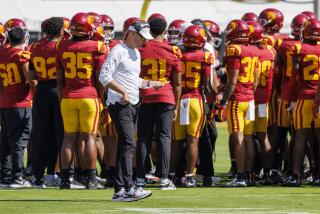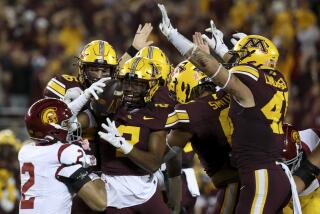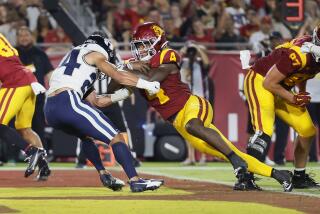Trojans becoming converts on two-point plays
- Share via
Let’s get right to the (extra) point:
What in the name of percentage football is Lane Kiffin thinking by regularly forsaking sure-thing, point-after-touchdown conversion kicks and going for two?
Trojans fans accustomed to leisurely food or restroom breaks after touchdowns have taken to staying in their seats when USC reaches the end zone.
Because who knows what kind of crazy thing might happen next. And whether it will work.
USC has converted only two of seven two-point attempts, going 0 for 3 in last week’s 32-21 victory at Minnesota. Meantime, kicker Joe Houston has made all seven of his conversion kicks — many after shifting from an unconventional spread formation.
The new philosophy might have cost bettors a few bucks — USC was favored by 11½ points at Minnesota — but it has not kept the Trojans from victory.
“It’s being aggressive,” special teams coordinator John Baxter said. “It’s pushing the pace, pushing the envelope and forcing our opponents to prepare for the Trojans in a multifaceted way.
“Even if they don’t work, they work.”
USC figures to get plenty of practice, or at least give future opponents more to think about, when it plays Washington State in its Pacific 10 Conference opener Saturday at Pullman, Wash.
The Trojans are a 22-point favorites over the 1-2 Cougars. The last time the Trojans visited Martin Stadium, two years ago, they scored 10 touchdowns in a 69-0 victory.
USC kicked after each one, which might happen again against the seemingly overmatched Cougars.
But don’t expect the Trojans to do so without first shifting out of a formation that hearkens the “swinging gate” setup, where linemen split wide to the sidelines before moving into a traditional kicking set.
“Whenever we’ve gone against another team like that, I always remember that of the 20 minutes set aside for special teams, 10 minutes was wasted on having to prepare for it,” Kiffin said, grinning. “So I like that aspect of it.”
Kiffin advanced the approach after hiring Baxter, who earned a reputation as an innovative special teams coach during 13 seasons at Fresno State.
Fresno State needed any edge it could find, especially during nonconference play when it annually traveled to take on traditional powers. Competing in the same conference with Boise State, another innovator, also forced the Bulldogs to adapt.
Baxter’s approach and Kiffin’s willingness to embrace it was evident during spring practice and training camp, when the Trojans may have devoted more time to special teams than they had in several years under former coach Pete Carroll.
USC unveiled its new philosophy after its first touchdown. A few moments after quarterback Matt Barkley passed to receiver David Ausberry for a first-quarter score at Hawaii, backup quarterback Mitch Mustain lined up in a shotgun formation with linemen, receivers and Houston, the kicker, split wide to the sidelines. Mustain misfired on a pass to Ausberry, who was shielded from defenders by a troika of linemen, but the Trojans were undeterred.
Out of a traditional nonshifting set, Barkley completed a two-point conversion pass in the first quarter and then misfired on one in the second. Mustain then crossed the goal line in the third quarter of the Trojans’ 49-36 victory.
USC attempted no two-point conversions in its 17-14 victory over Virginia before failing on two passes and a run at Minnesota.
Kiffin acknowledges that he has sometimes ignored the well-known “two-point conversion chart” that gives coaches a roadmap of when to go for two. “The feel of the game,” he said, can override the percentages.
Despite his team’s conversion rate, Kiffin does not plan to change his two-point stance.
“It’s no different than when certain parts of your passing game or blitzes or whatever aren’t working,” he said. “You get better at it. It’s not like you have to scratch it.”
Trojans players say they love the mentality.
“I’m like Kiff — put our foot on their necks,” senior receiver Ronald Johnson said. “When I’m playing video games, I’m going for two; I’m not kicking extra points.”
Mustain also is happy, especially with his role as a holder-triggerman. The fifth-year senior from Arkansas is charged with reading the defense. If the opponent presents a certain look, Mustain can run or pass.
“We usually have a couple options within a given play,” he said. “And then there’s always the option to shift and kick it. If you’re unsure, if it’s hazy, just do that.”
Houston is fine either way. He operated out of similar formations at El Camino College.
“They just need to keep me between the hash marks,” he said, chuckling. “In the first game, they sent me out wide and by the time I got to the [kicking] spot, I looked up at the play clock and there was only 11 seconds [left]. It was a like a field goal.”
Baxter has slightly adjusted that formation since. But there is no plan to modify the aggressive approach, regardless of the attention it has caused.
“If it’s stirred up this much controversy,” he said, “imagine what it’s stirred up on the practice field of our opponents.”
gary.klein@latimes.com
twitter.com/latimesklein
More to Read
Fight on! Are you a true Trojans fan?
Get our Times of Troy newsletter for USC insights, news and much more.
You may occasionally receive promotional content from the Los Angeles Times.







